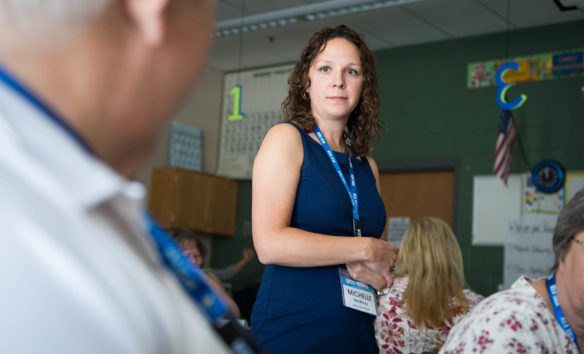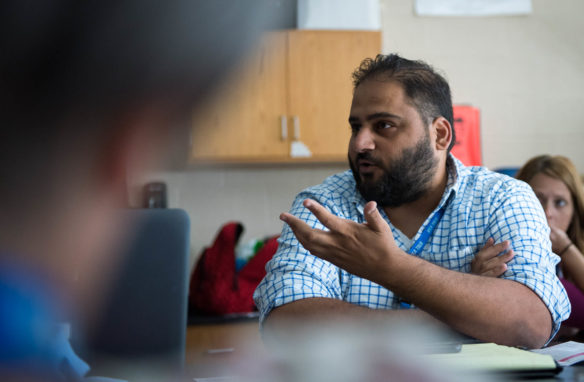
Michelle Hendricks, an instructional coach at Boston Elementary School (Nelson County), listens to a fellow educator during her presentation on reducing classroom time lost in transitions at the Let’s TALK: Conversations About Effective Teaching and Learning conference. Hendricks’ seminar addressed how to reduce transition time by completing necessary tasks calmly, quickly and efficiently.
Photo by Bobby Ellis, June 12, 2017
By Mike Marsee
michael.marsee@education.ky.gov
What if there were a way to add up to 30 minutes of instructional time to the school day without keeping teachers and students in school any longer?
Michelle Hendricks has been working on that, and she has found a way to add at least some teaching time to a typically tight schedule.
Hendricks, an instructional coach at Boston School (Nelson County) and the author of a blog, “New Teachers’ Guide,” said teachers lose a large amount of time in transitions, which includes everything from passing papers to lining up for the restroom.
“Those things have to be done, but you can do them more efficiently and get some of that time back,” Hendricks said.
Hendricks presented her thoughts on what she calls engineering efficiency last month at the Let’s TALK: Conversations About Effective Teaching and Learning conference in Lexington. She said reducing transition time in the classroom involves completing necessary chores calmly, quickly and efficiently before returning to the task at hand in order to create more time for teaching.
“We don’t have enough time, and if you look at the responses on the TELL survey, it reflects that,” Hendricks said.
In the Teaching, Empowering, Leading and Learning (TELL) Kentucky survey conducted by the Kentucky Department of Education earlier this year, 23 percent of teachers said they do not have sufficient instructional time to meet the needs of all students, and 25 percent said the non-instructional time provided is insufficient.
Hendricks noted that a great deal of time is lost in transitions. She said there are about 20 transitions per day, and she estimated that they take about 90 seconds each, which adds up to:
- 30 minutes out of a six-hour school day;
- 2-1/2 hours out of a 30-hour week; and
- 90 hours in a 36-week school year.
“When I say I don’t have enough time to teach my content, there’s my time,” Hendricks said.

Harsh Upadhyay, a mathematics teacher at Seneca High School (Jefferson County), asks a question during Michelle Hendricks’ seminar at the Let’s TALK conference. Upadhyay said classroom efficiency is as important in high school as it is in elementary school.
Photo by Bobby Ellis, June 12, 2017
Harsh Upadhyay, a mathematics teacher at Seneca High School (Jefferson County), said he’s amazed by how much time is lost during routine activities.
“That’s basically the entire testing season,” said Upadhyay.
Amanda Ellis, an association commissioner in the Kentucky Department of Education’s Office of Teaching and Learning, said educators need to be able to use as much time of the time available to them as possible to teach their students.
“The time teachers spend with their students in the classroom is so valuable, and finding ways to free up even a few more minutes of that time is a worthwhile effort,” Ellis said. “Placing an emphasis on efficiency can give teachers the opportunity to best use the time they do have to teach and provide support for students each and every day.”
Hendricks said elementary school teachers’ first instructions to students at the start of a new school year is often on a subject that isn’t part of the curriculum.
“Before they teach anything, they have to teach procedures,” she said.
She said that’s the ideal time to introduce classroom management techniques that will evolve from procedures to routines. That can mean telling students how they are expected to start the class, gathering their attention, preventing late or absent students from disrupting the class and lining students up quickly and quietly to move to the next class or to lunch or recess.
Introducing those procedures is important for teachers to establish control of the classroom and can lead to higher student achievement. She recommended five steps for introducing procedures outlined by author Harry Wong in “The First Days of School: How to Be an Effective Teacher:”
- Number the steps
- Model and describe
- Practice
- Transfer of ownership, which gives students responsibility in the process
- Review and reflect on how the procedures are working as necessary
The need for efficiency and the ability to create it aren’t limited to the elementary level. Caitlin Adkins, an English teacher at Hopkins County Central High School, said transitions can be tricky at that level as well.
“I feel like transitions can be a little hairy just to make sure that things go smoothly and students know the expectations I have for them every day in the classroom,” she said.
Adkins said the most difficult transition is “probably the beginning of a class period, when the bell rings, just getting them all in their seats, making sure they’re not wandering around, making sure that they know what to be doing and getting them focused for the day.”
Upadhyay said he also has researched classroom efficiency and has come to realize how important it is in high school.
“The need for efficient time in transitions is very important. Especially in a math class, we don’t have enough time. I want to be as efficient as possible when it comes to not wasting any instructional time,” he said.
Hendricks challenged her colleagues at the Let’s TALK conference to draw up step-by-step expectations for what students should do in a multi-step routine, such as changing classes in elementary school. In one example, she set a goal of having students who are transitioning from her class to another to line up quietly, quickly and with their materials in 20 seconds.
In addition to the objective and the target time, she spelled out a rationale in student-friendly language, saying lining up efficiently and without struggle “shows respect for others and for our learning time. So in this classroom, we are going to line up quickly and quietly without touching other students.”
To get to the goal, she spelled out these expectations of her students for each step of the process:
- When the teacher closes the class and tells students it’s time to pack up, students wait for cues.
- When she says, “one” and holds up one finger, students pack their materials silently and put them on their desks.
- When she says, “two” and holds up two fingers, students stand up behind their desks and push in their chair.
- When she says “three” and holds up three fingers, students take their materials and file through the rows toward the door at voice level zero.
Eventually, Hendricks said, she tries to reach the point of giving only nonverbal signals. The idea of using this process is to establish procedures that lead to orderly routines.
“If we set the bar, students will do it,” Hendricks said.
Hendricks said educators often focus on big-picture questions such as, “What needs to happen to fix education?” but many of the answers lie in smaller details.
“There are a lot of things out there that are beyond our control, but we can choose in our classrooms to be great,” she said.
MORE INFO …
Michelle Hendricks michelle.hendricks@nelson.kyschools.us
Hendricks’ materials from her presentation at the Let’s TALK conference
Caitlin Adkins caitlin.adkins@hopkins.kyschools.us
Harsh Upadhyay harsh.upadhyay@jefferson.kyschools.us



Leave A Comment